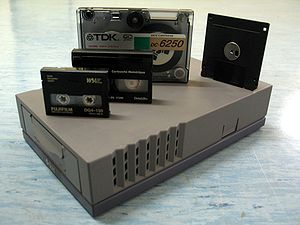Tape drive: Difference between revisions
m [ []] |
{{Compu-hardware-stub}} using AWB |
||
| Line 1: | Line 1: | ||
[[image:Dds tape drive 01.jpg|thumb|300px|DDS tape drive. Above, from right hand side: microdisk 3.5", DC tape (250 MB, 6 mm, 1020 ft), DL tape (8 mm, 367 ft), DDS 4 tape (20 GB uncompressed, 4 mm, 492 ft)]] |
[[image:Dds tape drive 01.jpg|thumb|300px|DDS tape drive. Above, from right hand side: microdisk 3.5", DC tape (250 MB, 6 mm, 1020 ft), DL tape (8 mm, 367 ft), DDS 4 tape (20 GB uncompressed, 4 mm, 492 ft)]] |
||
A '''tape drive''', also known as a '''streamer''', is a [[ |
A '''tape drive''', also known as a '''streamer''', is a [[computer hardware|peripheral device]] that reads and writes data stored on a [[magnetic tape]] or a [[punched tape]]. It is typically used for archival storage of data stored on [[hard drive]]s. Tape drives are sequential-access, and must wind past all preceding data to read any one particular piece of data. They are not the fastest form of data storage, as they are sequential, but are long lasting and cost efficient. Modern [[Linear Tape-Open|LTO]] drives can reach burst transfer rates of over 160 MB/s, with average transfer rates in the 80 MB/s range. Tape drives can be connected with [[SCSI]] (most common), [[parallel port]], [[IDE]], [[USB]], [[FireWire]] or [[optical fibre]]. |
||
Tape drives can range in capacity from a few megabytes to upwards of 800 GB compressed. Tape drive storage is usually referred to with the assumption of 2:1 [[Data compression|compression]]; the raw storage capacity is known as the [[native capacity]]. |
Tape drives can range in capacity from a few megabytes to upwards of 800 GB compressed. Tape drive storage is usually referred to with the assumption of 2:1 [[Data compression|compression]]; the raw storage capacity is known as the [[native capacity]]. |
||
| Line 16: | Line 16: | ||
In the 1980s some forms of tape drives were used as inexpensive alternatives to [[disk drive]]s, examples include the [[ZX Microdrive]] and [[Rotronics Wafadrive]]. |
In the 1980s some forms of tape drives were used as inexpensive alternatives to [[disk drive]]s, examples include the [[ZX Microdrive]] and [[Rotronics Wafadrive]]. |
||
{{Compu-hardware-stub}} |
|||
<div class="boilerplate metadata" id="stub"> |
|||
<!-- added padding-top because otherwise the Hdd stub.png image juts upwards into any text directly above this template. --> |
|||
{| cellpadding="0" cellspacing="0" style="background-color: transparent; padding-top: 8px;" |
|||
|- |
|||
|[[Image:harddisk.svg|40px]]||'' This [[computer hardware]]-related article is a [[Wikipedia:Perfect stub article|stub]]. You can [[Wikipedia:Find or fix a stub|help]] Wikipedia by [{{SERVER}}{{localurl:{{NAMESPACE}}:{{PAGENAME}}|action=edit}} expanding it]''. |
|||
|} |
|||
</div>[[Category:Computer hardware stubs]] |
|||
==References== |
==References== |
||
Revision as of 06:13, 19 June 2006

A tape drive, also known as a streamer, is a peripheral device that reads and writes data stored on a magnetic tape or a punched tape. It is typically used for archival storage of data stored on hard drives. Tape drives are sequential-access, and must wind past all preceding data to read any one particular piece of data. They are not the fastest form of data storage, as they are sequential, but are long lasting and cost efficient. Modern LTO drives can reach burst transfer rates of over 160 MB/s, with average transfer rates in the 80 MB/s range. Tape drives can be connected with SCSI (most common), parallel port, IDE, USB, FireWire or optical fibre.
Tape drives can range in capacity from a few megabytes to upwards of 800 GB compressed. Tape drive storage is usually referred to with the assumption of 2:1 compression; the raw storage capacity is known as the native capacity.
Tapes and drives come in various formats. These formats include:
- Digital Data Storage (DDS),
- Digital Linear Tape (DLT),
- Linear Tape-Open (LTO),
- Advanced Intelligent Tape (AIT), and
- Quarter Inch Cartridge (QIC), also known as Scalable Linear Recording (SLR)
Tape drives can be found inside autoloaders and tape libraries.
In the 1980s some forms of tape drives were used as inexpensive alternatives to disk drives, examples include the ZX Microdrive and Rotronics Wafadrive.
References
This article is based on material taken from the Free On-line Dictionary of Computing prior to 1 November 2008 and incorporated under the "relicensing" terms of the GFDL, version 1.3 or later.
